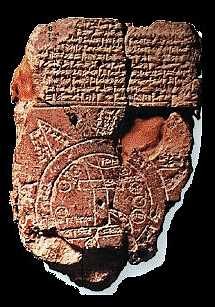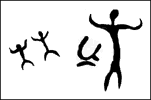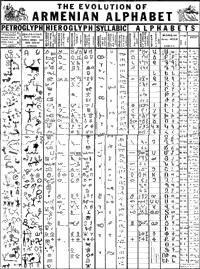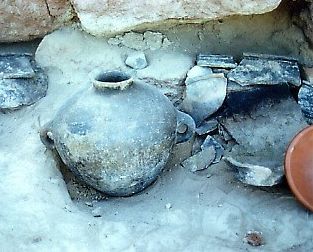What They Left Behind
| "It
is impossible to have a culture this advanced with no written
language" |
Beyond stone carvings
(called "pictograms", since they represented ideas through pictures,
as opposed to an alphabet, which captures sounds and is used
to create words and sentences to express ideas), there is very
little to suggest what a native language was like in Armenia
between the Paleolithic and Urartian periods.
Detailed maps showing
ancient fortified towns and roads that exist to this day are
scrawled on the sides of stone foundations, as are complex trigonometry
and geometric formulas pointing to astral, solar and lunar phases.
The inscriptions even include one of the first calendars and
compasses ever created. The Metsamorians and their ancestors
were the earliest known civilization to forge copper, bronze
and iron, they created a pantheon of gods that foreshadow the
Greek pantheon. Having one of the greatest cultures of the Bronze
Age (the "Metsamor Kingdom"), Ancestral Armenians curiously
left no written words behind.
 Emma
Khanzatian, director of excavations at Metsamor, and the Grande
Dame of archeology in Armenia, does not find a missing language
all that curious. Emma
Khanzatian, director of excavations at Metsamor, and the Grande
Dame of archeology in Armenia, does not find a missing language
all that curious.
"It is impossible
to have a culture this advanced with no written language," Ms.
Khanzatian says. "Just impossible. They were among the leaders
in the known world at that time in science, industry and trade.
Metsamor era artifacts are found in Egypt, Syria, Persia, India
and Central Asia. Their distinct black and geometric pottery
made its way to Mycenae, they may even have created the wheel.
They knew trigonometry, astronomy and geomtetry--you can have
none of these sciences without notation, the forms of writing.
How could they leave nothing in writing behind?"
Part of how is shown
by several strata of excavations at Metsamor and other ancient
cities. Black, charred earth, pottery and skeletons lie in heaps
in several layers from the middle Bronze and early Iron Age.
Sieges and burnt earth policy began far before recent memory.
If anything like parchment was created along with spectacular
bronze and gold objects uncovered at Metsamor, AdaBlur, Jerahovit
and MokhraBlur, it was surely burned along with the population.
More recent layers of excavation show continued sieges and burning
in the common era, including a 4th century layer
that was a result of struggle between Pagan and Christian armies.
It is not until the Urartian period (ca. 1300-550 BC) that
a written language has been found and that was borrowed from
Sumerians and Assyrians. Stone was the preferred medium of expression,
though there is some proof that wood and leather parchment were
used along with clay tablets in Mesopotamia and Egypt. But other
than signs of zodiac, maps and geometric equations, no signs
of writing from the Metsamor period have been uncovered.
Khanzatian smiles
and nods her head towards a central mound at Metsamor. "We haven’t
begun to uncover what lies beneath this ground. And just think
what must be under a city as old as Jerahovit or Aigeshat. Just
because we haven’t found it doesn’t mean it isn’t there." A
wizened face carved from years of excavating the windswept earth
on the Ararat plain laughs and points to the central mound.
"And somewhere under the main citadel lies a treasure as important
as any gold artifact the archive."
|
The Indo-Europeans
| "the
Indo-European culture is now figured to be on or near the
Armenian Plateau, with migrations into Asia and Europe beginning
as early as 7,000 BC" |
To appreciate just how great a treasure Ms. Khanzatian refers
to, we should go back a few thousand years to the beginnings of
culture on the Armenian plateau. We’re going back oh, about 9000
years, when the first settlements built around the copper industry
appeared in the Ararat Valley. Now, while the oldest layer uncovered
in any city the size of Metsamor is a mere 7000 years old, there
are so many prehistoric settlements in Armenia to suggest civilization
is very old indeed. These include the site of a one million BC
skeleton in the Hrazdan Gorge and a 90,000 BC Stone Age settlement
in Yerevan.
The Armenian language is
part of the Indo-European language family. The name ‘Indo-European’
is itself a variation of ‘Indo-Aryan’, encompassing Sanskrit, Persian,
Slavic, Germanic and Romance languages. The Indo-European language tree
takes in more territory, speaking wise, than any other on earth.
One of the greatest
evolutions in history occurred when Indo-Europeans began to
migrate throughout Asia and Europe. Classical historians put
this event sometime in the 3rd millennium BC and thought the
source for Indo-Europeans were someplace in Central Asia. History
is always being reinvented, though, in the face of new discoveries,
and the source of the Indo-European culture is now figured to
be on or near the Armenian Plateau, with migrations into Asia
and Europe beginning as early as 7,000 BC. Moving first into
Central Asia and India to the East, the Russian landmass in
the North, and then through the Balkans into Europe, successive
waves of Indo-Europeans culminated in a ca. 2000 BC migration
into the Eastern Mediterranean which hallmarks the beginning
of the Greek Doric culture. From there the culture made a full
circle when the Hittites and later when Thraco-Phrygian tribes
(among the losers of the Trojan War) entered the Armenian Plateau
and re-introduced an altered Indo-European language back to
its birthplace.
In one of the pictograms
carved during the Mesolithic period there is a representation
of a man with both arms raised, his legs slightly bent. The
top half of the figure is considered the precursor of the letter
for "Ah", the main root sound in all Indo-European languages,
represented in  Armenian by the letter "²". Speculation is that the first
sound made was "ah", and came to represent "man", "first" and
"one". The raised arms indicate worship. In Armenian, the sound
‘Ah’ combined with "R’ forms a second main root, "AR", which
means ‘light;, ‘sun’ and ‘god’. Numerous words in Armenian begin
with ‘AR’, among them arev (sun) and Ararat. Ararat
is a complex word: ‘Ar-Ar’ meaning a greater god, or more than
one god, and ‘-at’ a precursor of the Armenian ‘hat’, which
means ‘a piece of’. Thus, ‘Ar-ar-at’ is ‘a piece of the gods’,
or ‘a piece of creation’.
Armenian by the letter "²". Speculation is that the first
sound made was "ah", and came to represent "man", "first" and
"one". The raised arms indicate worship. In Armenian, the sound
‘Ah’ combined with "R’ forms a second main root, "AR", which
means ‘light;, ‘sun’ and ‘god’. Numerous words in Armenian begin
with ‘AR’, among them arev (sun) and Ararat. Ararat
is a complex word: ‘Ar-Ar’ meaning a greater god, or more than
one god, and ‘-at’ a precursor of the Armenian ‘hat’, which
means ‘a piece of’. Thus, ‘Ar-ar-at’ is ‘a piece of the gods’,
or ‘a piece of creation’.

Others originating
in the pictograms include ‘barev’, which in modern Armenian
means ‘hello’, but comes from an older root meaning ‘to belong
to’, represented in the pictograms as a dwelling or house.

Metsamor reached its zenith in the Mid Bronze Age, when it encompassed
more than 200 hectares (about 800 acres). At the center of trade
between Asia and the budding cultures in the West, the mineral
mines and metal forges in the Metsamor kingdom were the focus
of constant warfare with neighboring city-states, and by the
end of the 3rd millennium, with the growing empires
in Mesopotamia. The Metsamor culture thrived through the Bronze
and early Iron Age, when it was integrated into the Urartu Empire
(ca. 7th c. BC). The city of Metsamor continued
under the Persians, Greeks, Romans, Byzantines and Ottomans
until the 18th century, when it was abandoned. 6700
years of continuous inhabitation not a bad record.
|
The Second Wave
|
An equally sophisticated culture sprang up by Lake Van, in Anatolia.
More closely located to the Mesopotamian cultures, the ancestral
Armenian tribes in the Van region developed a series of city-states
by the 3rd millennium BC, with federations formed and
reformed between them for most of the Bronze Age period. Excavations
in the Van region are undeveloped, so that most of what we know
about the really prehistoric epochs is that uncovered in the Republic,
but it is thought that the Van Kingdom was equally, or even more
developed than that in the Ararat Valley, since the territory
was described as a rich land between the rivers, with their head
at the "mountains of the gods" (described as "Arartu"). This description
comes from the oldest epoch poem, Gilgamesh (ca. 5th
millennium BC). To earn that kind of praise, a land would have
to be very rich indeed.
 By
the 2nd millennium BC, trading between the tribes on the Armenian
plateau led to a loose federation led by the Nairi, which were
based around Southern Lake Van. The Nairi were recorded as early
as 2000 BC on Assyrian cuneiform as the people from the "land
between the rivers," holding about 60 tribes and 100 cities.
The Nairi were one tribe among many, but their name became synonymous
with that for the entire region. Among the tribes in Nairi was
one called Urartu. From what we know of the tribes, their customs
and traditions were similar to others found in Mesopotamia,
and they mixed Semitic or Ugaritic origins with their earlier
Indo-European genetic and cultural roots. By
the 2nd millennium BC, trading between the tribes on the Armenian
plateau led to a loose federation led by the Nairi, which were
based around Southern Lake Van. The Nairi were recorded as early
as 2000 BC on Assyrian cuneiform as the people from the "land
between the rivers," holding about 60 tribes and 100 cities.
The Nairi were one tribe among many, but their name became synonymous
with that for the entire region. Among the tribes in Nairi was
one called Urartu. From what we know of the tribes, their customs
and traditions were similar to others found in Mesopotamia,
and they mixed Semitic or Ugaritic origins with their earlier
Indo-European genetic and cultural roots.
Also around 2000
BC, a second wave of Indo-European migration began, this time
coming full circle back to the Armenian plateau. Thousands of
years of development created distinct dialects and physical
attributes, which further influenced the "mother tribes" in
Armenia. Among them were the Hittites, which entered the region
of Asia Minor around 2000 BC. The Hittites mention a vassal
kingdom of theirs called the Haiassa-Aza, which are considered
one of the direct links with the Armenian culture. The Haiassa-Aza
were Indo-European, had extensive contacts with the tribes of
the Nairi, and it is believed that architectural and cultural
influences from the Hittites were filtered into this region
through them.
The immigrating
Indo-European tribes brought with them forms of writing some
say the "Hyksossian" script used in the Sinai between 1730-1580
BC comes from the same branch of ancestors as those who brought
the "Haikasian" script to the Armenian plateau (ca. 1500 BC).
But a quick look at the Evolution of the Armenian Script shows
striking similarities between these ‘new’ scripts and those
from the Metsamor period (ca. 5000 BC), which was established
on the plateau at least 3000 years before then.
Another wave of
Indo-Europeans entered the scene around the 12th c. BC, by a
race called "the people of the sea". These are thought to be
Thraco-Phrygians retreating from Mycenae and Thrace and Phrygia,
probably survivors of the Trojan War, which occurred at the
same time. First inhabiting the land immediately East of the
Trojan kingdom in Asia Minor, the Thraco-Phrygians settled on
the Western edges of the Armenian plateau and intermingled with
the Haiassa-Aza, further developing Indo-European language,
culture and physical features.
|


|